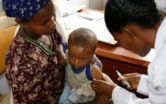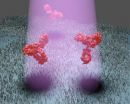(Press-News.org) Soldiers deployed to tropical and sunny climates are coming home with increased risk factors for a threat far from the battlefield: skin cancer.
In a retrospective study of about 200 veterans seen at the post-deployment clinic of the Tennessee Valley Healthcare System of the U.S. Department of Veterans Affairs, researchers from Vanderbilt University Medical Center and the Tennessee Valley Healthcare System found that 62 percent of military personnel reported getting sunburned while deployed abroad, including cases of skin blistering. In addition, 29 percent noted a change in the color, shape or size of their moles (a skin cancer risk factor) since being deployed to tropical zones, but only 4 percent reported receiving a skin examination from a physician since deployment.
"The past decade of United States combat missions, including operations in Iraq and Afghanistan, have occurred at a more equatorial latitude than the mean center of the United States population, increasing the potential for ultraviolet irradiance and the development of skin cancer," said Jennifer Powers, M.D., assistant professor of Medicine in the Division of Dermatology and lead researcher on the study.
Powers presented the results at the World Congress on Cancers of the Skin, held recently in Edinburgh, Scotland.
The study also found that only 22 percent of military personnel were made very aware of the risks of sun exposure, and while 77 percent reported being exposed to bright sunlight for more than four hours a day while working, only 27 percent had regular access to sunscreen. Just under one-third of respondents (32 percent) reported having no access to sunscreen at all while working.
Previous research cited in the literature shows that 34 percent of United States military veterans who developed melanoma had also been deployed to tropical climates. In comparison, only 6 percent of non-military melanoma patients had spent time in tropical climates.
Melanoma claims 9,700 lives in the United States each year.
While military personnel deployed overseas may often have survival priorities other than avoiding sun exposure, Powers notes that the study indicates a potential deficiency for access to sun protection that could translate to long-term health risks.
"This study demonstrates room for improvement for skin cancer prevention and early detection in the military population, including possible screening of higher-risk personnel," she said.
INFORMATION:
Skin cancer risks higher for soldiers serving abroad
2014-09-15
ELSE PRESS RELEASES FROM THIS DATE:
The science behind swimming
2014-09-15
At nearly 100 feet long and weighing as much as 170 tons, the blue whale is the largest creature on the planet, and by far the heaviest living thing ever seen on Earth. So there's no way it could have anything in common with the tiniest fish larvae, which measure millimeters in length and tip the scales at a fraction of a gram, right?
Not so fast, says L. Mahadevan, the Lola England de Valpine Professor of Applied Mathematics, of Organismic and Evolutionary Biology, and of Physics.
Using simple hydrodynamics, a team of researchers led by Mahadevan was able to show ...
Brain Development in Schizophrenia Strays from the Normal Path
2014-09-15
Philadelphia, PA, September 15, 2014 – Schizophrenia is generally considered to be a disorder of brain development and it shares many risk factors, both genetic and environmental, with other neurodevelopmental disorders such as autism and intellectual disability.
The normal path for brain development is determined by the combined effects of a complex network of genes and a wide range of environmental factors.
However, longitudinal brain imaging studies in both healthy and patient populations are required in order to map the disturbances in brain structures as they emerge, ...
Sleep disorders widely undiagnosed in individuals with multiple sclerosis
2014-09-15
(SACRAMENTO, Calif.) —In what may be the largest study of sleep problems among individuals with multiple sclerosis (MS), researchers at UC Davis have found that widely undiagnosed sleep disorders may be at the root of the most common and disabling symptom of the disease: fatigue.
Conducted in over 2,300 individuals in Northern California with multiple sclerosis, the large, population-based study found that, overall, more than 70 percent of participants screened positive for one or more sleep disorders.
The research highlights the importance of diagnosing the root causes ...
How evolutionary principles could help save our world
2014-09-15
The age of the Anthropocene--the scientific name given to our current geologic age--is dominated by human impacts on our environment. A warming climate. Increased resistance of pathogens and pests. A swelling population. Coping with these modern global challenges requires application of what one might call a more-ancient principle: evolution.
That's the recommendation of a diverse group of researchers, in a paper published today in the online version of the journal Science. A majority of the nine authors on the paper have received funding from the National Science Foundation ...
Boosting armor for nuclear-waste eating microbes
2014-09-15
EAST LANSING, Mich. – A microbe developed to clean up nuclear waste and patented by a Michigan State University researcher has just been improved.
In earlier research, Gemma Reguera, MSU microbiologist, identified that Geobacter bacteria's tiny conductive hair-like appendages, or pili, did the yeoman's share of remediation. By increasing the strength of the pili nanowires, she improved their ability to clean up uranium and other toxic wastes.
In new research, published in the current issue of Applied and Environmental Microbiology, Reguera has added an additional layer ...
Selway complex and Johnson Bar fires in Idaho
2014-09-15
Two fires are seen burning in this satellite image taken by the Aqua satellite on September 11, 2014. The Selway complex of fires had been previously reported located 30 miles west of Darby, MT. It appears a new fire may have started again in this complex. Currently the size of the complex is 1,659 fires. The fire is mostly contained and there will be no additional reporting on this fire unless activity increases. It is, for the most part, contained.
The Johnson Bar fire started with a lightning strike on August 03, 2014. To date, 8,867 acres have been affected. ...
New glaucoma culprit is found
2014-09-15
Glaucoma, a leading cause of irreversible blindness, is associated with elevated pressure in the eye. This elevated pressure essentially is due to a plumbing problem. Fluid builds up in the eye, increasing pressure and eventually damaging the optic nerve. For nearly 150 years, researchers have been trying to understand what causes the blockage that prevents the eye from draining properly.
In a unique study of human ocular cells, a multi-institution research team led by a biomedical engineer at Northwestern University has found a new culprit. Glaucoma appears to be a consequence ...
Getting hot and wet in Vermont
2014-09-15
Here's your northern Vermont forecast for the rest of this century: annual precipitation will increase by between a third and half an inch per decade, while average temperatures will rise some five degrees Fahrenheit by midcentury. By late in the century, average temperatures will have spiked more than eight degrees. In July, by 2100, the City of Burlington will have at least ten additional days above ninety degrees. The growing season picks up 43 more days. Looking at ski conditions, expect annual snowfall at six major ski resorts to decline about fifty percent by century's ...
Mayo finds many liver transplant patients can avoid costly stay in ICU after surgery
2014-09-15
JACKSONVILLE, Fla., Sept. 12, 2014 — The liver transplant team at Mayo Clinic in Florida has found, based on 12 years of experience, that more than half of patients receiving a new liver can be "fast-tracked" to return to a surgical ward room following their transplant, bypassing a one- or two-day stay in the Intensive Care Unit (ICU).
In the September issue of the American Journal of Transplantation, the physicians and researchers have turned their knowledge of who can be safely fast-tracked into a scoring system that other transplant centers can also use — thus sparing ...
The shadow of a disease
2014-09-15
This news release is available in German.
In future, some diseases might be diagnosed earlier and treated more effectively. Researchers at the Max Planck Institute for the Science of Light in Erlangen have developed an optical method that makes individual proteins, such as the proteins characteristic of some cancers, visible. Other methods that achieve this only work if the target biomolecules have first been labelled with fluorescent tags; In general, however, that approach is difficult or even impossible. By contrast, with their method, coined iSCAT, the researchers ...




